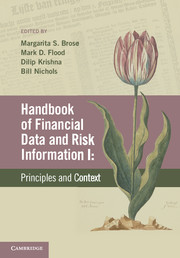Book contents
- Frontmatter
- Contents
- List of contributors
- Preface
- VOLUME I: PRINCIPLES AND CONTEXT
- PART I RISK MANAGEMENT CONTEXT FOR FINANCIAL DATA
- 1 A brief history of financial risk and information
- 2 Risk management
- 3 Portfolio risk monitoring
- 4 Frameworks for systemic risk monitoring
- 5 Data-driven regulation and financial reform: one perspective from industry on the financial crisis
- PART II REQUIREMENTS AND SOURCES FOR FINANCIAL RISK MANAGEMENT
- PART III REGULATORY DATA
- Index – Volume I
- References
5 - Data-driven regulation and financial reform: one perspective from industry on the financial crisis
from PART I - RISK MANAGEMENT CONTEXT FOR FINANCIAL DATA
- Frontmatter
- Contents
- List of contributors
- Preface
- VOLUME I: PRINCIPLES AND CONTEXT
- PART I RISK MANAGEMENT CONTEXT FOR FINANCIAL DATA
- 1 A brief history of financial risk and information
- 2 Risk management
- 3 Portfolio risk monitoring
- 4 Frameworks for systemic risk monitoring
- 5 Data-driven regulation and financial reform: one perspective from industry on the financial crisis
- PART II REQUIREMENTS AND SOURCES FOR FINANCIAL RISK MANAGEMENT
- PART III REGULATORY DATA
- Index – Volume I
- References
Summary
Introduction
The information basis for regulation and supervision has evolved to one driven more by structured data, often formulated in concept in a multinational context for comparability and equity. Data-driven regulation means that the information set guiding official supervision is guided and dominated by formal collections of well-defined, primarily numeric data reported by financial institutions. While data-driven regulation introduces many operational efficiencies into supervisory processes, it also introduces layers of abstraction and quantification that have the potential to distract attention from the underlying financial reality. Supervisors may be misled if the collected data do not fully and accurately convey the underlying situation in a timely fashion.
Information and data issues are intimately connected to recent events. This was a modern, global financial crisis. While it had its origins in housing markets, housing policy and securitizations, complex network effects operated through traded instruments and counterparty risks. It highlighted risks that were known in the literature but were neither ranked highly nor pursued by the official sector. The crisis occurred during the implementation of Basel II methods of regulation based upon quantified risks using proprietary data and internal models of institutions. These methods were in the process of being restructured and recalibrated. In any event they did not prevent failures.
The regulation of financial institutions and markets is not a science, although it borrows statistical techniques and theory from portfolio models and microeconomics. It is not normative in that there is disagreement on the standards, trade-offs and weights among goals.
- Type
- Chapter
- Information
- Handbook of Financial Data and Risk Information IPrinciples and Context, pp. 148 - 174Publisher: Cambridge University PressPrint publication year: 2014
References
- 1
- Cited by



